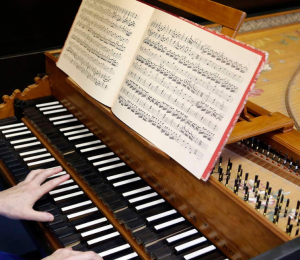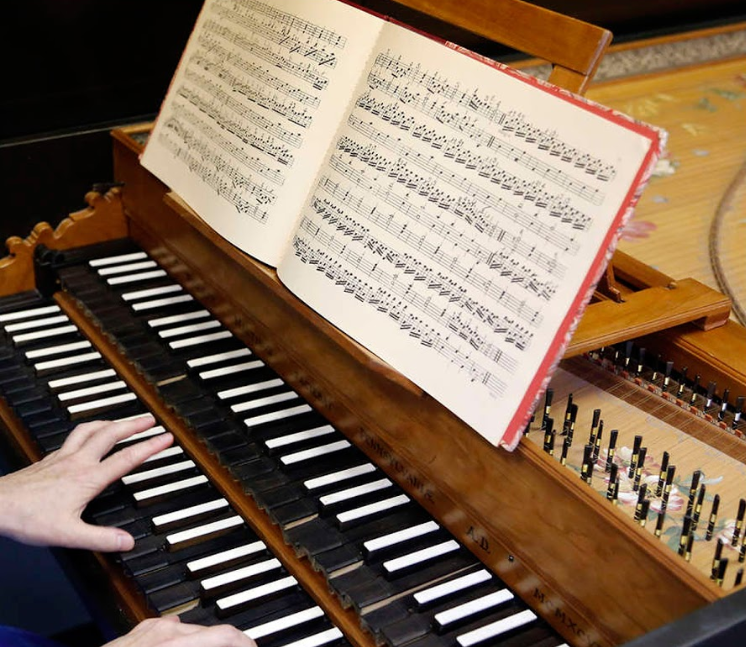Johann Sebastian Bach Concerto Festival!
Wednesday, October 2nd, 12:00 Noon
Charles Library Event Space
Presented by Dr. Joyce Lindorff
with Boyer College Harpsichordists
and Baroque Strings
Light refreshments served. Boyer recital credit given.
 More than a mere antecedent to the modern piano, the harpsichord is a keyboard string instrument with an otherworldly sound. Its metallic timbre and precise articulation result from an internal mechanism: quills pluck the strings when the keys are depressed, and dampers silence the strings when the keys are released. Creating the effect of cascading notes, this mechanical operation is ideal for the performance of contrapuntal music because of the clarity it lends to the middle and lower voices; in other words, the design and function of the instrument met the musical demands of its time.
More than a mere antecedent to the modern piano, the harpsichord is a keyboard string instrument with an otherworldly sound. Its metallic timbre and precise articulation result from an internal mechanism: quills pluck the strings when the keys are depressed, and dampers silence the strings when the keys are released. Creating the effect of cascading notes, this mechanical operation is ideal for the performance of contrapuntal music because of the clarity it lends to the middle and lower voices; in other words, the design and function of the instrument met the musical demands of its time.
Emerging in the years around 1400, the harpsichord reached its zenith in the 1700s. During this era, luminaries such as Johann Sebastian Bach (1685-1750), François Couperin (1668-1733), George Frideric Handel (1685-1759), and Domenico Scarlatti (1685-1757) composed some of the finest music for the instrument. Famous examples from the solo repertory include J. S. Bach’s The Well-Tempered Clavier, a collection of 48 preludes and fugues in two volumes, and Scarlatti’s 555 keyboard sonatas. The harpsichord was also regularly used for accompaniment in the performance of both sacred and secular music. This role kept the instrument in service until the turn of the nineteenth century, when changes in musical taste—reflected in the rising popularity of the pianoforte—diminished its presence. The resurgence of the harpsichord in the late 1800s may be attributed to the special qualities mentioned above, namely its suitability for the performance of early music.
On Wednesday, October 2, Dr. Joyce Lindorff and her colleagues from Boyer College will present performances of J. S. Bach’s concerti for one, two, and four harpsichords. (The latter is a transcription of a solo concerto from Vivaldi’s L’estro armonico, Op. 3, no. 10.) Listeners will have the opportunity to experience the singular sound of the instrument thrown into relief by contrasting tutti (full ensemble) and solo sections. Do not forgo what is sure to be an eminently satisfying musical event.
Consult the following sources for more information:
Kottick, Edward L. A History of the Harpsichord. Bloomington: Indiana University Press, 2003.
Pollens, Stewart. The Early Pianoforte. Cambridge: Cambridge University Press, 1995.
Ripin, Edwin M., Howard Schott, John Koster, Denzil Wraight, Beryl Kenyon de Pascual, G. Grant O’Brien, Alfons Huber, William R. Dowd, Charles Mould, Lance Whitehead, and Martin Elste. “Harpsichord.” Grove Music Online. 2001; Accessed 11 Sep. 2019. https://www-oxfordmusiconline-com.libproxy.temple.edu/grovemusic/view/10.1093/gmo/9781561592630.001.0001/omo-9781561592630-e-0000012420.
Wolff, Christoph. Bach: Essays on His Life and Music. Cambridge: Harvard University Press, 1991.
Wolff, Christoph, and Walter Emery. “Bach, Johann Sebastian.” Grove Music Online. 2001; Accessed 11 Sep. 2019. https://www-oxfordmusiconline-com.libproxy.temple.edu/grovemusic/view/10.1093/gmo/9781561592630.001.0001/omo-9781561592630-e-6002278195.
Gary Sampsell is a second-year PhD student in the Music Studies program at Boyer College. His research interests include the musical culture of baroque-era Saxony and Austro-German reception of early music in the nineteenth century.
